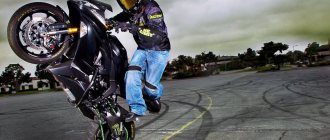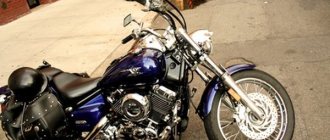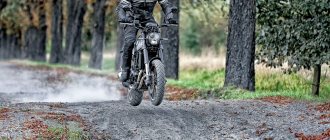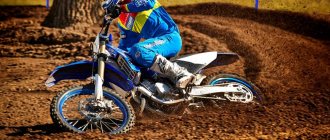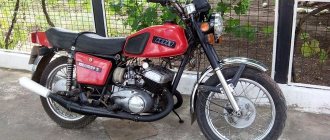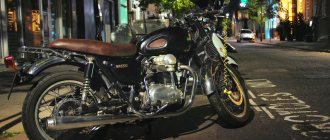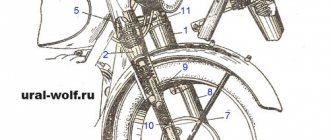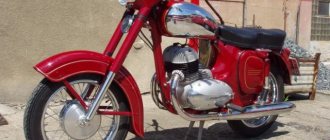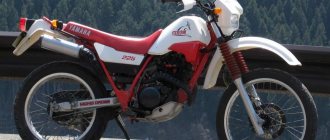Technical specification tables for a motorcycle chassis often indicate parameters such as rake And trail, But what does it mean?
Rake
Rake - represents the angle between two imaginary lines. The first is vertical and extends to the ground, passing through the center of the motorcycle's front wheel. The second line runs through the center of the head tube and relates to the characteristics of the frame rather than the fork. The rake is often mistaken for the fork angle, although in practice they may not coincide. Choppers have rake - their forks are very extended forward. Sports motorcycles have rake - their forks are closer to the vertical. A typical sports bike might have a rake of 25 degrees, while a chopper will have closer to 45 degrees. Touring motorcycles tend to have an angle of 29, while cruisers are around 32.
A larger rake does two things: firstly, it increases the wheelbase, and secondly, it increases the trail of the motorcycle.
MY MOTORCYCLE
When you make some kind of custom, or simply make small changes to the design of the motorcycle, especially when it comes to the frame and other elements, then these changes will certainly affect the behavior of your bike on the road in the future! Why does this happen?, because we fit into the “motorcycle geometry” that the engineers created at the factory and it affects! Therefore, when building (remaking) an iron horse, it is imperative to take this fact into account.
So let's talk about “motorcycle geometry”:
The steering column angle (α) is one of the parameters that determines the geometry of the motorcycle. This is the name given to a group of geometric quantities that directly affect the stability and controllability of the machine. This angle is measured between the vertical and the axis passing through the centers of the steering column bearings. In English literature it is called “rake angle”. Sometimes this angle is measured not from the vertical, but from the horizontal, the so-called “castor”.
Of course, a castor of 66 degrees is equal to a tilt angle (90 - 66 =) 24 degrees. Another value is directly related to the angle of the steering column - reach (c), or “trail” in English. It is equal to the distance between the point of contact of the front tire with the road and the imaginary point of intersection of the steering column axis with the road.
To understand how these quantities affect the behavior of a motorcycle, consider a special case: the front wheel turns to the left under the influence of external forces (driver efforts, gust of wind, road unevenness). Since the intersection points of the steering column axis with the road and the contact of the tire with the road do not coincide, drift of the front tire occurs, and its magnitude is directly proportional to the angle of rotation of the wheel and the offset. This drift, in turn, causes the appearance of a friction force (F), which tends to return the wheel to its previous position.
Thus, the greater the reach, the better the stability of the motorcycle when driving in a straight line. But at the same time, with an increased reach, it is more difficult to take the car out of straight-line motion. With a low reach, the motorcycle becomes easy to control, but extremely sensitive to attempts to lead it off the straight path.
Not only the fork offset affects the handling of the motorcycle, but also its base (L) . This is a value equal to the distance between the axles of the wheels (in our case, the distance between the points of contact of the wheels with the road is more important, but these values are practically the same). , the stability coefficient (R) is usually used
For classic motorcycles, the stability coefficient is usually 6.3-7.0%. Steadfast cruisers are famous for their large values - over 7%, and for nimble sportbikes it is within 5%. For racing motorcycles it is less than 6%, and “dummies” should not ride such machines. The values of the geometric parameters of some characteristic representatives of various classes of motorcycles are given in the table.
Some (already old) sportbikes (Ducaii 996 and Ducaii 748, Bimota SB8) provide adjustments to the angle of the steering column and, accordingly, the reach due to the fact that the steering column bearings are installed in eccentric cages. For example, on the Ducati 996, the angle of inclination varies from 23.5 to 24.5 degrees, and the reach is up to 97 mm. The same goal can be achieved by adjusting the rear suspension: the higher the rear of the motorcycle is raised, the smaller the angle of the steering column and, accordingly, the reach. The same effect can be achieved by lowering the traverses along the pipes of the telescopic fork.
Experienced motorcycle racers use the front brake to increase the agility of the motorcycle. Here's how to perform this trick: Enter a turn and, by braking, achieve “sagging” of the front fork. This reduces the angle of the steering column and the reach - therefore, it makes it easier for you to control the motorcycle...
Fork angle
The fork angle is the angle between the vertical line drawn through the front wheel mounting axis and the center line of the fork leg.
When riding a motorcycle, braking and suspension travel will also significantly change the rake and trail . For example, if you brake hard, the suspension will compress and reduce rake and trail .
Comparing rake and trail for different motorcycles can give you some idea of how they handle, even if you've never ridden one.
To achieve stability at speed, balance and light steering, the chassis incorporates a compromise between rack and trail . For example, a very large rake provides excellent stability at high speed, but is not well suited for normal use. To maintain good stability and proper handling, the rake should be in the normal range (approximately 22 to 32).
Trail Braking
A concept that is known on the track, but used by everyone, from fragile beginner girls to rugged bearded bikers. But only professional racers always remember about it and practice this phenomenon consciously.
Have you ever noticed that when you apply the front brake, or when you perhaps stand on the pegs and lean on the handlebars, at such moments the handling of the motorcycle changes? I'm not talking about balance and not about the horror in your eyes from the clamped brake and wheel lock when you are trying with all your might to cope with the situation.
When braking or other load is applied to the front of the motorcycle, the front fork obviously sags. The meaning of the technique is CONTROLLED braking when maneuvering in a turn. As the fork compressed, its angle changed. The continuation point of the fork has approached the contact patch, therefore Trail... What is he? That's right, it became smaller. It is easier for the motorcycle to enter the turn, but do not forget that you are moving and braking, and even in a turn! Professionals have been honing this skill for a long time. City motorcyclists commit such control methods on an unconscious level, without realizing that they are doing some kind of Trail Braking.
Moreover, your goal is not to stupidly press the lever. You control your speed and trajectory by squeezing the front brake, from start to finish of the maneuver. In the city, this is necessary when the situation tends to stalemate, the hair on your head stands on end, and the counter for the correct action inexorably rolls down to zero, because someone decided to pass the same turn in front of you or did not give way. The reason could be any. The point is that you smoothly adjust your speed with the brake, monitor the angle of inclination and the radius of the turn, and when the peak of the turn has been passed, you also smoothly release the brake so that the motorcycle does not buck, but calmly levels out due to the speed.
Trail Braking requires the rider to have a thorough understanding of the process, nerves of steel and trust in both his own mind and the capabilities of the motorcycle. Any unnecessary body movements, sudden bursts of gas or squeezing the brake more than necessary and you will already fly out of the turn.
Modifications
Forks can be modified or replaced, thereby changing the geometry of the bike.
Changing the fork length
Increasing the length of the fork, for example by going from rigid to suspension, raises the front of the bike and thus reduces the head angle.[10] Lengthening the fork will have the opposite effect on a motorcycle's rake since the rake is measured in the opposite direction.
As a rule of thumb, a 10mm change in fork length results in a half-degree change in steering axis angle.
Changing the fork offset
Increasing the fork offset reduces the trail, and if done on an existing fork by bending without lengthening the blades, the fork is shortened.[24]
Recommendations
- Lemond Racing Cycles. 2006. Archived from the original on August 4, 2006. Retrieved August 8, 2006.
- Paul Aston (28 September 2015). "First Ride: Nikolai Mojo GeoMetron." PinkBike. Retrieved February 26, 2021. GeoMetron Parts: Head angle 62-63.5°, depending on shock and fork length.
- Matt Pacocha (December 23, 2011). "Cane Creek AngleSet Review." BikeRadar. Retrieved April 14, 2013.
- Rider Member (June 30, 2009). "Suspension and Understanding Motorcycle Rake and Track." Rider Magazine. Retrieved December 14, 2013. Rake angle is the angle, in degrees, that the steering column of a frame... leans back from the vertical.
- Moto Guzzi USA. 2006. Archived from the original on December 12, 2006. Retrieved December 11, 2006.
- "Geometry of bicycle control." Designed by Calfi. Retrieved April 6, 2011.
- Kevin Atkinson (2013). The Singer's Story: Cars, Commercial Vehicles, Bicycles and Motorcycles
. Veloce Publishing Ltd. Retrieved December 14, 2013. The curved front fork of a bicycle is a patent of George Singer and is still in use today. - "Rake and Trail Calculator." RB Racing. Retrieved December 14, 2013.
- Hornsby, Andy (2006). "Back to school." Archived from the original on April 4, 2005. Retrieved December 12, 2006.
- ^ a b
Rinard, Damon (1996). "Fork length." Archived from the original October 26, 2007. Retrieved October 18, 2007. - "Frame Geometry". Archived from the original April 20, 2011. Retrieved April 7, 2011.
- Josh Putnam. "Steering Geometry: What is Wake?" Archived from the original April 30, 2011. Retrieved April 7, 2011.
- "Introduction to Bicycle Geometry and Control." Chunk 666. Archived from the original April 30, 2011. Retrieved April 7, 2011.
- ^ a b
Whitt, Frank R.;
Jim Papadopoulos (1982). "Chapter 8". Bicycle Science
(Third ed.). Massachusetts Institute of Technology. ISBN 0-262-73154-1. - Putnam, Josh (2006). "Steering Geometry: What is Wake?" Retrieved August 8, 2006.
- Cossalter, Vittore (2006). "TRAIL". Archived from the original on May 10, 2006. Retrieved December 14, 2006.
- Cossalter, Vittore (2006). Motorcycle Dynamics
(Second ed.).
Lulu.com. item 234. ISBN 978-1-4303-0861-4. [ self-published source
] - "MotoCzysz." 2006. Archived from the original on December 1, 2006. Retrieved December 14, 2006.
- Tony Foale (2006). Motorcycle Handling and Chassis Design: The Art and Science
. clause 3-1. ISBN 9788493328634. Retrieved October 18, 2013. the distance between the ground contact patch and the steering axis, measured at right angles to that axis. In SAE [this] is called "Mechanical Trace". - Vittore Cossalter (2006). Motorcycle dynamics
. paragraph 32. ISBN 9781430308614. Retrieved October 18, 2013. normal trail is the perpendicular distance between the front contact point and the steering column axis. - Watkins, Gregory K. "Dynamic Stability of a Fully Human-Powered Single-Track Vehicle" (PDF). Archived from the original (PDF) on July 17, 2006. Retrieved August 23, 2006.
- Foale, Tony (2002). Motorcycle handling and chassis design
. Tony Foale Design. pp. 3–11. ISBN 84-933286-1-8. Retrieved June 3, 2010. - Heine, Jan. "Bicycle Quarterly - Glossary." Vintage bicycle press. Archived from the original on May 21, 2010. Retrieved June 3, 2010.
- Matchak, Tom (2006). “Redirecting Forks and Changing Fork Angle” (PDF). Archived (PDF) from the original May 17, 2008. Retrieved May 30, 2008.
- "CHAPTER 39-27 MOTORCYCLE EQUIPMENT" (PDF). 2006. Retrieved December 14, 2006.
Damping
Suspension control
Finding a starting point for measuring shock compression and compression is a subjective process. First, write down the values that you already have. Find the overall compression range by relaxing the shock absorber to maximum and counting the number of turns or clicks to the original position. When working with damping adjusters, never tighten them tightly or you may damage internal components—just tighten them lightly at the end of the range.
Fault tolerance should be configured by touch. Press down on the front suspension and allow it to return to its original state on its own. This process should take about a second.
Turn the release controls to the full firm position and press the suspension down. It's coming back quite slowly, isn't it? Now tighten the screws completely and try again. You should notice a big difference in how the fork or shock behaves. They can return to their original position so quickly that they even slightly exceed the maximum value of the range, and then fall again.
Wheelbase
Wheelbase
This is
the horizontal
distance between the centers (or ground contact points) of the front and rear wheels. Wheelbase is a function of rear frame length, axle angle, and fork offset. This is similar to the term wheelbase used for cars and trains.
Wheelbase has a big influence on the longitudinal stability of a bicycle, [ clarification needed
] along with the height, the center of mass of the combined bike and rider. Short bikes are more suitable for wheelies and traffic jams.
Legal Requirements
The state of North Dakota (USA) actually has minimum and maximum requirements for rakes and trails for the “manufacture, sale, and safe operation of motorcycles on public roads.”[25]
"4. All motorcycles, except three-wheelers, must meet the following specifications regarding front wheel geometry:
MAXIMUM: tilt angle: 45 degrees; Trail: 14 inches [35.56 cm] positive MINIMUM: Angle: 20 degrees; Trace: 2 inches [5.08 cm] positive
The manufacturer's specifications shall include the specific rake and trail for each motorcycle or class of motorcycle, and the terms "rake" and "trail" shall be defined by the Director in regulations adopted pursuant to chapter 28-32."
Buy a used motorcycle: 50 inspection tips
Choosing a used motorcycle is always a gamble. Surprises can appear even if you buy a used device from an official dealer, for example, one that was given as a trade-in by the former owner. That is why you need to inspect a two-wheeled “second-hand” item with special care when purchasing. We have collected 50 tips from experienced motorcyclists, detailing where to look when choosing a motorcycle on the secondary market.
It should be noted that this is generalized information on the topic of choice, so it is worth studying thematic forums and communities dedicated to the devices you are interested in to find out what problems are typical for this particular model, and also acquire a service manual. However, even guided only by general theoretical knowledge, the risk of buying a problem bike is greatly reduced.
1. Choose among several offers
Having selected the options you are interested in, call the owners, check the availability of documents and the possibility of bargaining. Specify the reason for the sale - sometimes you can get an additional discount for urgency. And sometimes the urgency and the possibility of a discount (especially a big one) is a reason to think - they won’t give a big discount on a good motorcycle. Most likely, the low cost hides legal or technical problems.
Don't limit yourself to one option, brand or model - an alternative will never be superfluous
2. You should not consider devices with a clearly low price tag
There may be more problems with such a purchase than the imaginary benefits will bring. Often these are restored equipment or “dockless” motorcycles without documents, most likely stolen or imported into the country illegally. In both cases, the joy from the purchase will be short-lived - if you try to register the motorcycle with the traffic police, the equipment may be arrested.
3. Check with the seller for details of operation
You can ask to send additional photos of the main components of the motorcycle via social networks. The owner's profile will help to indirectly assess the operating and maintenance conditions of the bike. You can also search for the owner’s account on specialized forums and motorcycle websites.
A motorcycle used for training, training or racing is not the best choice among the variety of used market
4. Check the motorcycle for theft/prohibition of use
Use the traffic police website and the Carfax or Autocode service to check the history of the motorcycle and possibly prohibit registration actions. The autocode works mainly in Moscow, although sometimes it can be used to “punch” a motorcycle in regions.
5. Inspect the storage area
Find out where the bike was parked during the motorcycle season, whether the motorcycle was preserved at the end of summer, and check the storage conditions in winter. Give preference to warm garage storage with proper preservation - this will help to avoid rust, “shriveled” rubber parts and other problems associated with long-term parking on the street.
A motorcycle is a summer mode of transport and if it is not stored in the winter properly, it can quickly become unusable.
It is worth noting that many motorcycle dealerships selling used equipment pay more attention to eliminating minor visual defects and polishing the motorcycle to a shine than to the actual technical preparation of the bike.
Content
- 1 Wheelbase
- 2 Pivot angle 2.1 Bicycle head angle
- 2.2 Front angle of the motorcycle
- 8.1 Changing the fork length
